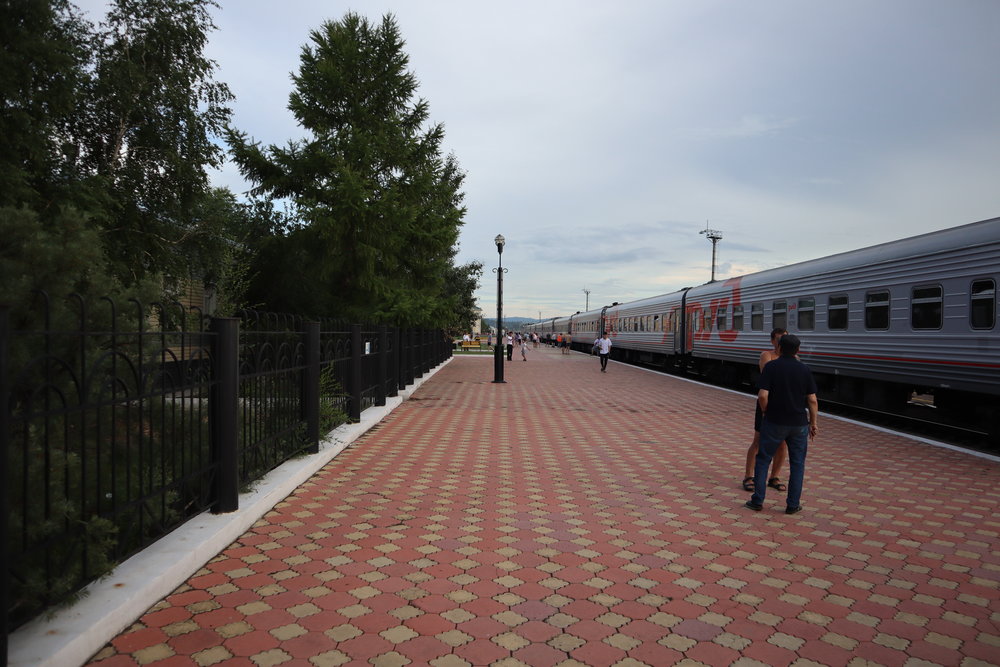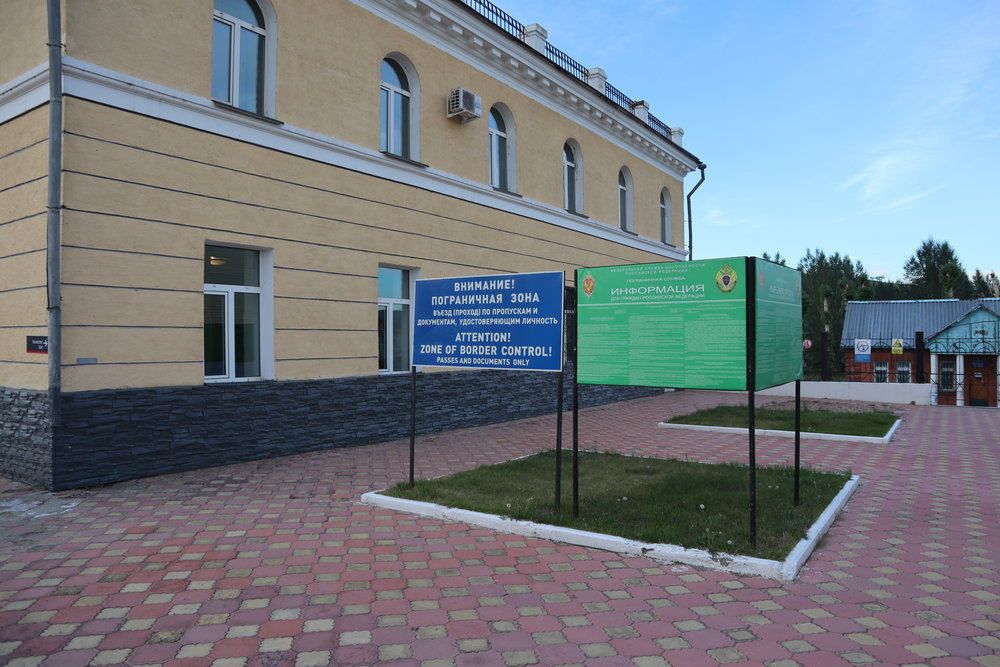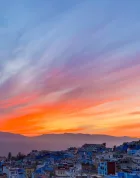So far along this journey, we had travelled from Moscow to Irkutsk along the “true” Trans-Siberian Railway, which is the stretch of track that lies entirely within Russia and leads all the way to Vladivostok on the Pacific coast.
From Irkutsk, we’d be heading to Beijing, and in doing so we were embarking on the Trans-Mongolian Railway, which branches off from the Russian mainline shortly after the city of Ulan-Ude. Along the way, we’d have a two-day stop in Mongolia’s capital of Ulaanbaatar in the middle of the journey.
A quick word about booking these tickets: while domestic Russian train tickets can be booked online, international ones such as this Irkutsk–Ulaanbaatar segment need to be booked in-person at the booking offices of any Russian train station.
Fortunately, we got this done pretty smoothly upon arriving in Moscow earlier during the trip, with the help of a FIFA World Cup volunteer who was willing to translate.
Trans-Mongolian Railway | Russian Railways Train No.306
Cabin: Second class
Route: Irkutsk to Ulaanbaatar
Date: Monday, July 16, 2018
Time: Departing 8:08am and arriving 6:50am the next day
Duration: 22 hours 42 minutes

Since we were issued paper tickets, we had to keep them with us for safekeeping all the way throughout the journey. When our train to Ulaanbaatar pulled up at Irkutsk Train Station for the bright-and-early 8am call, we presented the tickets to the conductor and made our way onboard Coach #3.
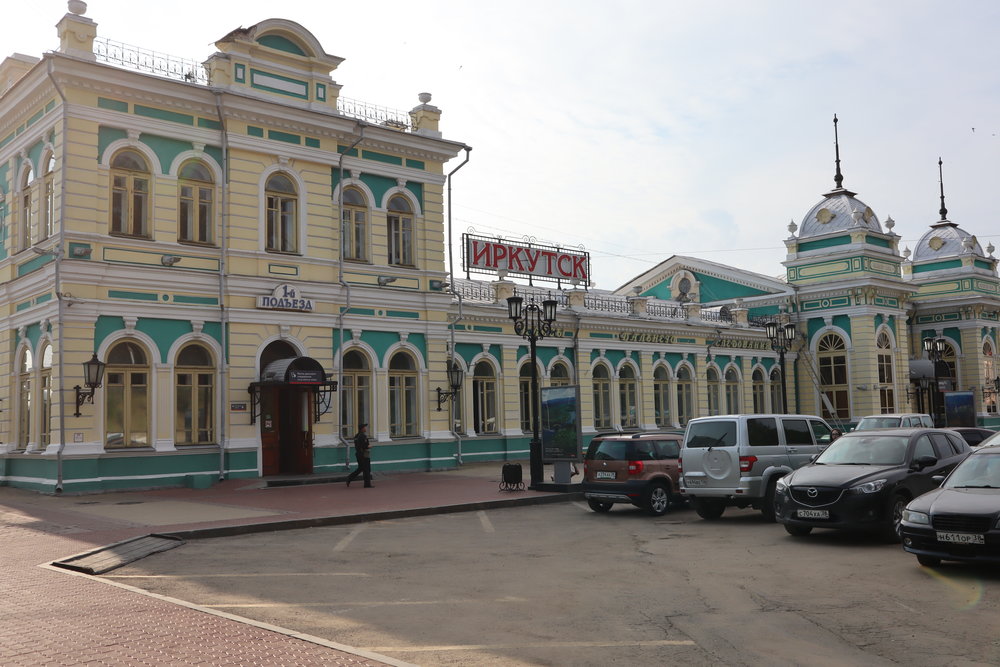
Irkutsk-Passazhirsky Railway Station
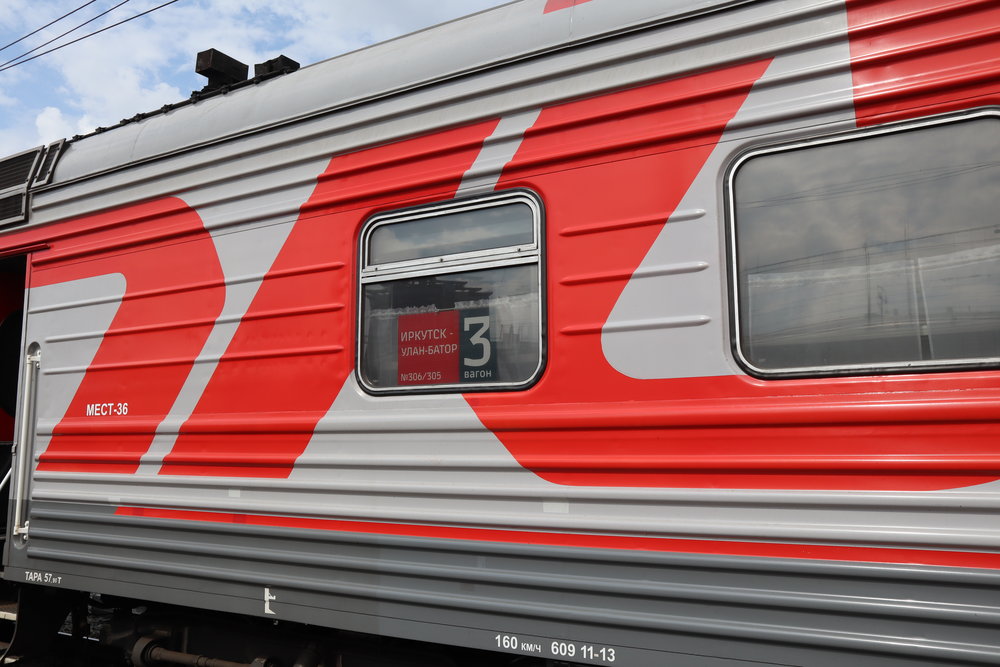
Trans-Mongolian Railways (RZD) – Coach #3
As you’d expect, Second Class represents a middle ground between the ultra-private First Class cabins and the open-air Third Class sleeping areas. Each compartment in Second Class has its own sliding door, and is shared between up to four passengers across two lower bunks and two upper bunks.

Trans-Mongolian Railway (RZD) Second Class – Compartment #3
A fellow passenger had already arrived in Compartment #3 before us, and the three of us would be sharing the compartment for the ride to Ulaanbaatar. We got to chatting with him, and found out that he lived in Ulaanbaatar but was originally from South Korea and still maintains strong ties to his home country. An interesting character for sure, he made for a decent travel companion for the 22-hour journey.
This was a Russian Railways train that was very similar to the Rossiya that we had taken between Nizhny Novgorod and Novosibirsk. Accordingly, the Second Class compartments are fitted out virtually identically to their First Class counterparts, except for the additional two bunks installed at eye-level.
Like in First Class, the lower bunks could be transformed into seats during the day and beds during the night, and there’s storage space in the headrests of each bunk, coat hangers and hooks, and barely functional in-seat entertainment.
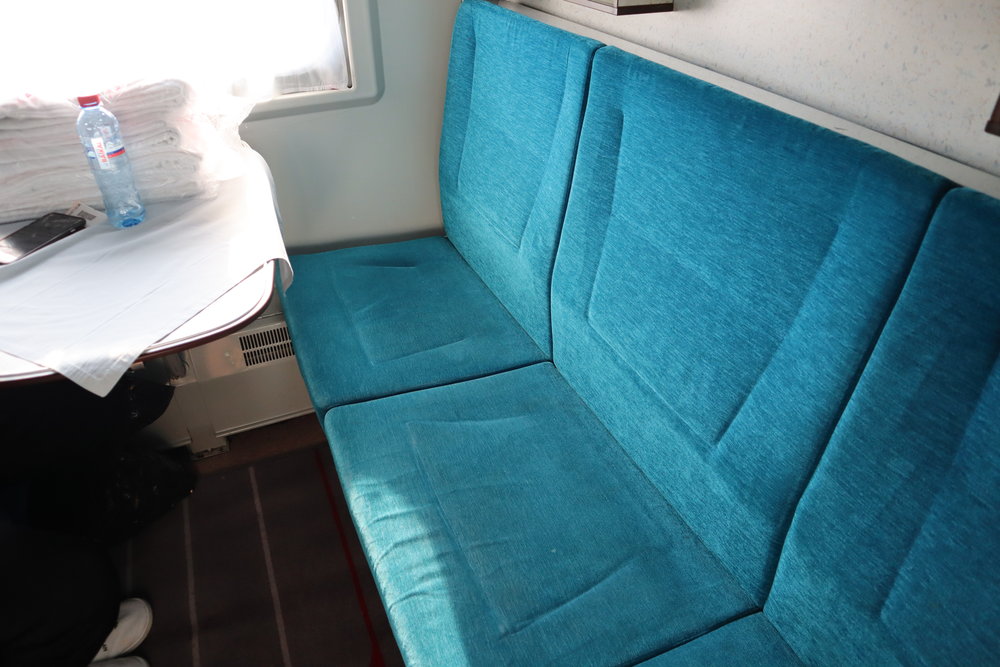
Trans-Mongolian Railway (RZD) Second Class – Lower bunk in seat mode
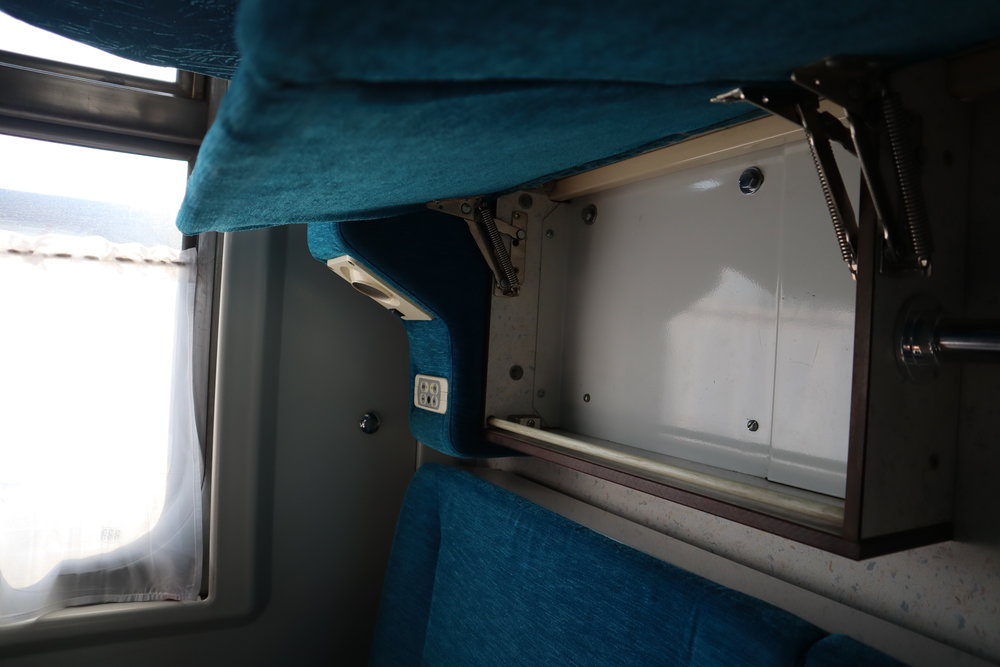
Trans-Mongolian Railway (RZD) Second Class – Storage compartments
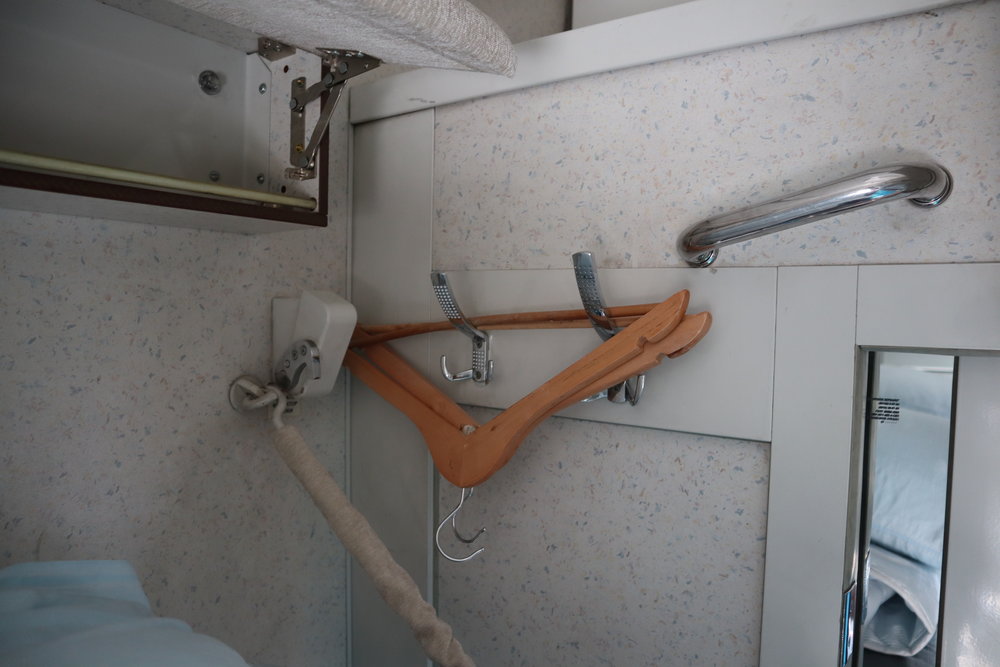
Trans-Mongolian Railway (RZD) Second Class – Coat hangers and hooks
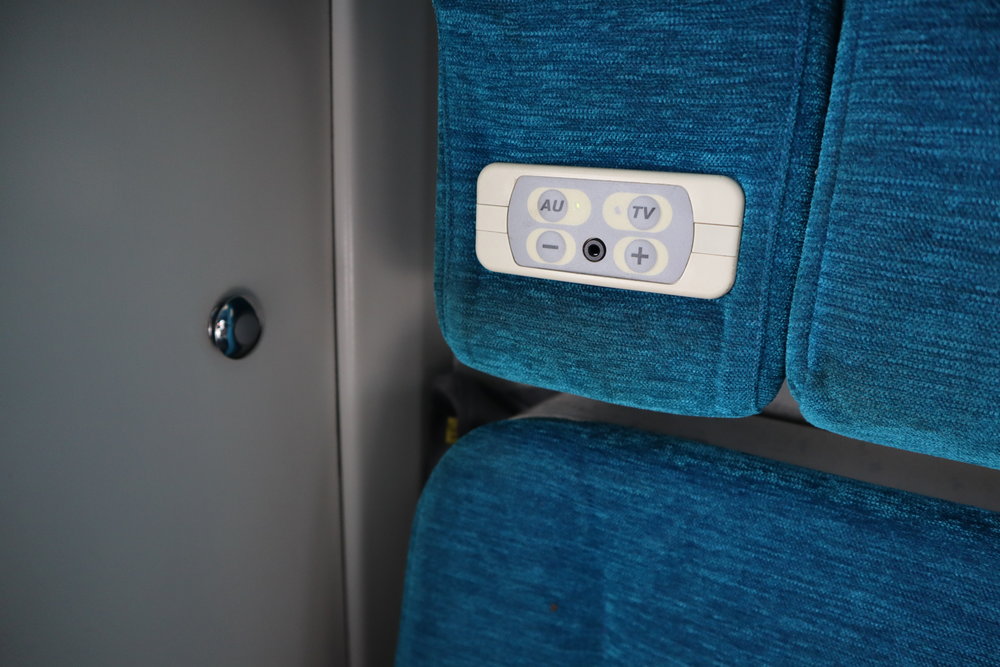
Trans-Mongolian Railway (RZD) Second Class – In-seat entertainment
Luggage could be stored under the seat – this time in a dedicated metal compartment – as well as in the lofted space above the train corridor.
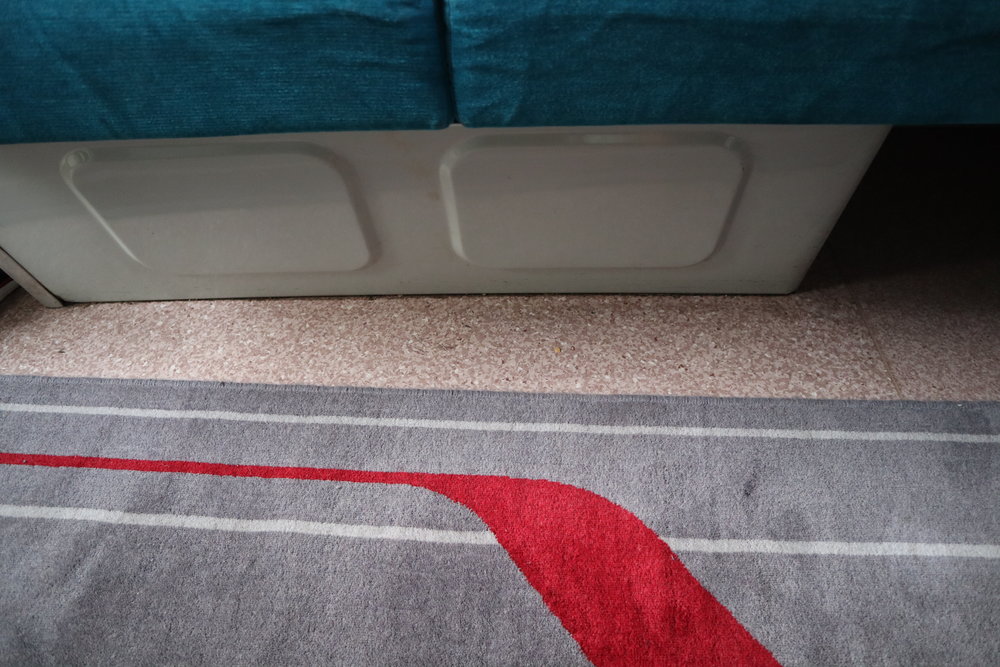
Trans-Mongolian Railway (RZD) Second Class – Under-seat luggage storage
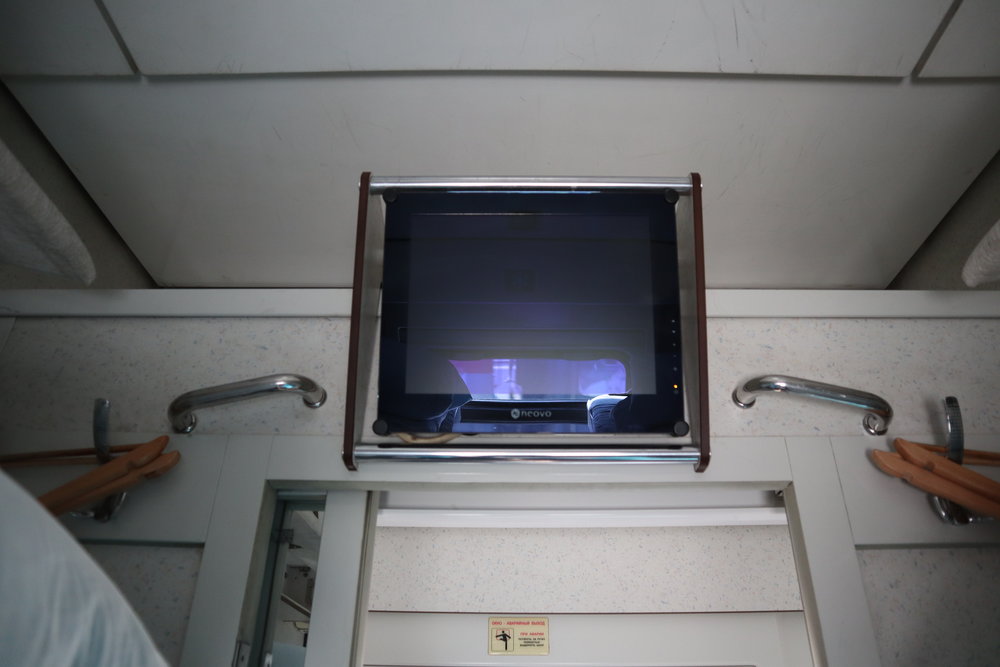
Trans-Mongolian Railway (RZD) Second Class – Overhead luggage storage
With the addition of upper bunks, there was also a small retractable step-ladder to help the upper bunk occupant make the climb.
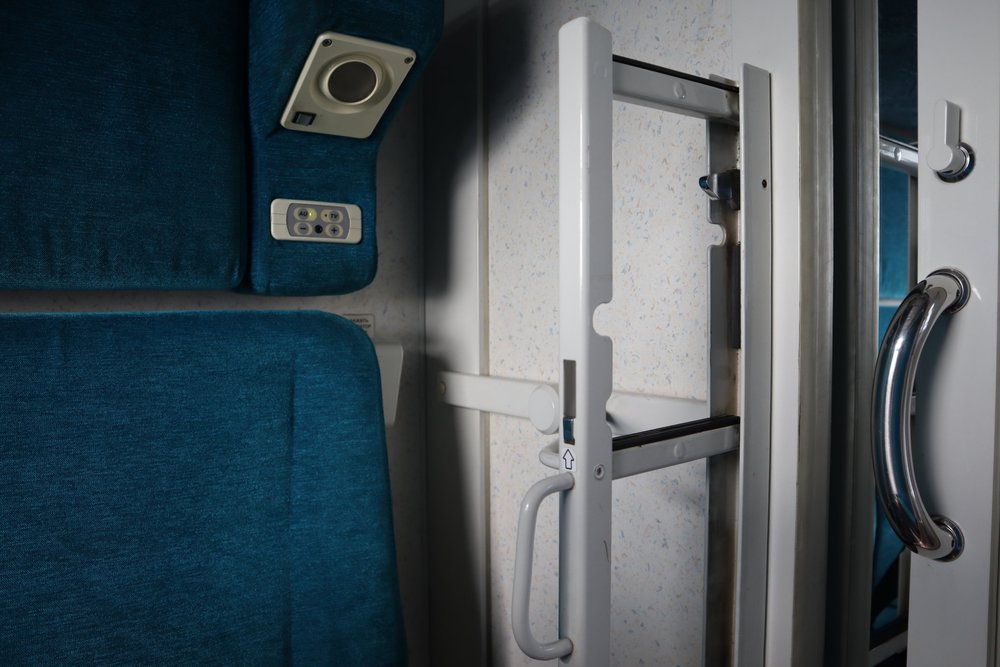
Trans-Mongolian Railway (RZD) Second Class – Retractable step-ladder
Bedding was readily available when we arrived, but unlike in First Class we had to make our beds ourselves.
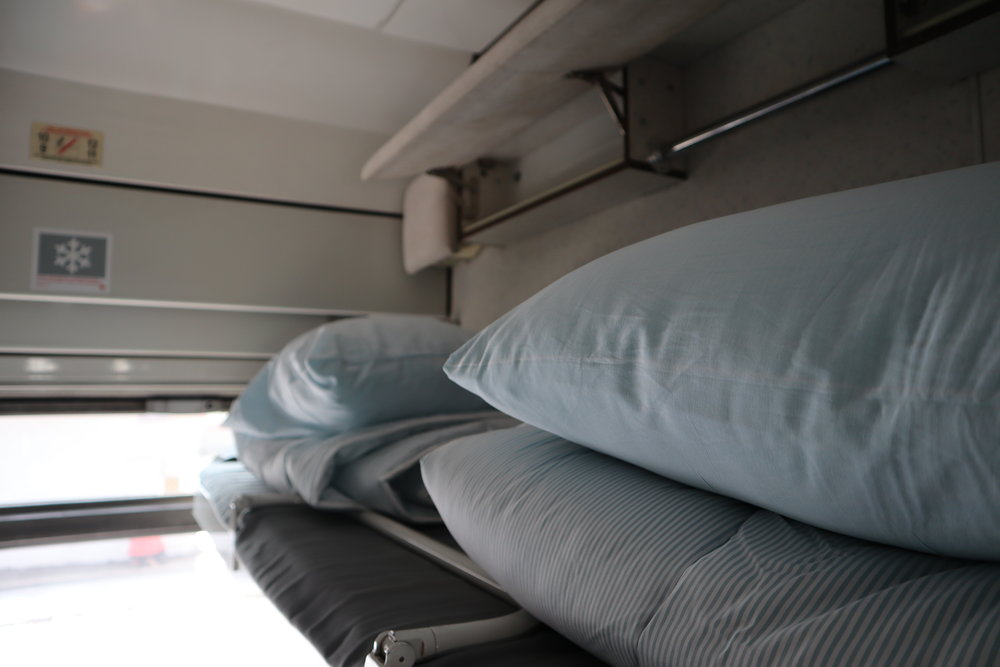
Trans-Mongolian Railway (RZD) Second Class – Bedding
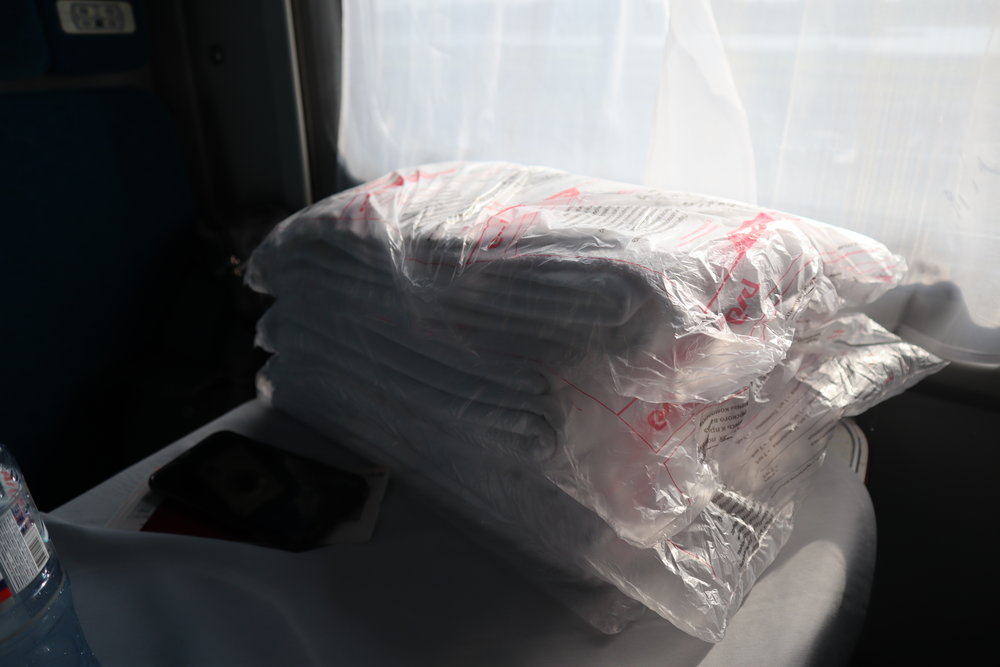
Trans-Mongolian Railway (RZD) Second Class – Bedding
Having gotten a good night’s sleep at our hotel in Irkutsk, we didn’t need to hit the hay immediately upon getting on the train this time. Instead, we had come extremely well-prepared with food and snacks, so we enjoyed a light impromptu brunch as we watched the scenery fly by.
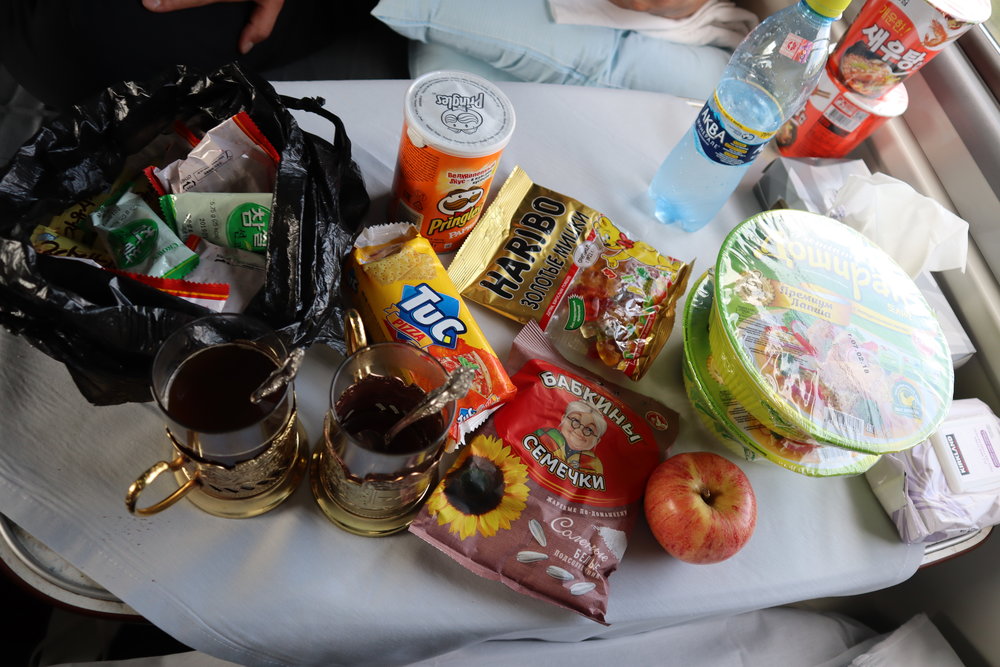
Trans-Mongolian Railway (RZD) Second Class – Nibbles and nosh
The scenery in this part of Siberia was finally starting to get a little more interesting. While we had spent virtually all of the journey so far looking at light woodlands and lush terrain, we were now making our way around the southern edges of Lake Baikal, and so there were more expansive and varied views to be enjoyed.
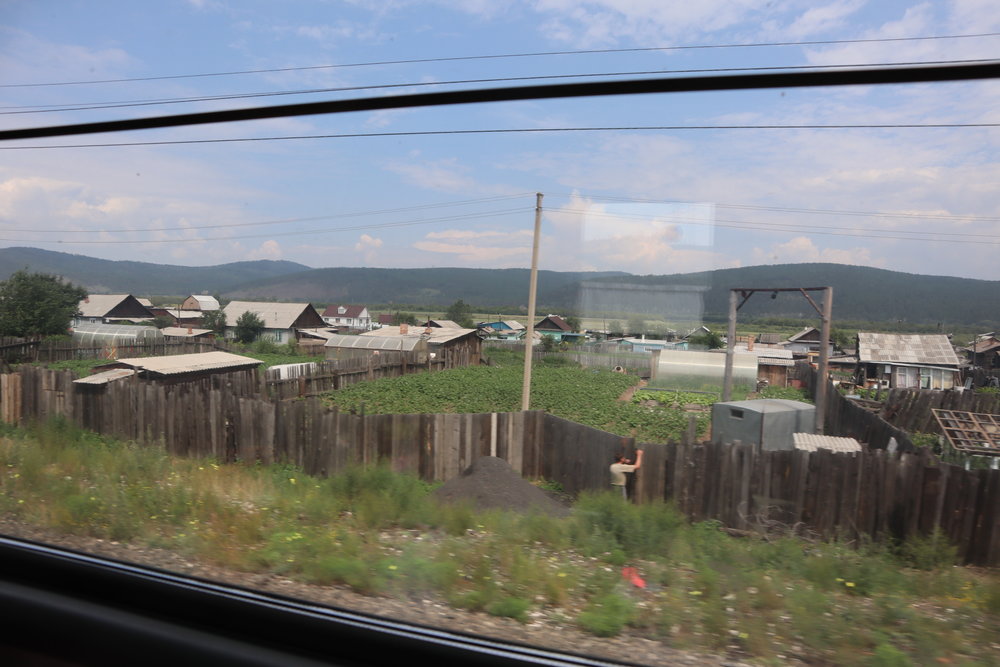
Trans-Mongolian Railway (RZD) Second Class – Scenery near Irkutsk
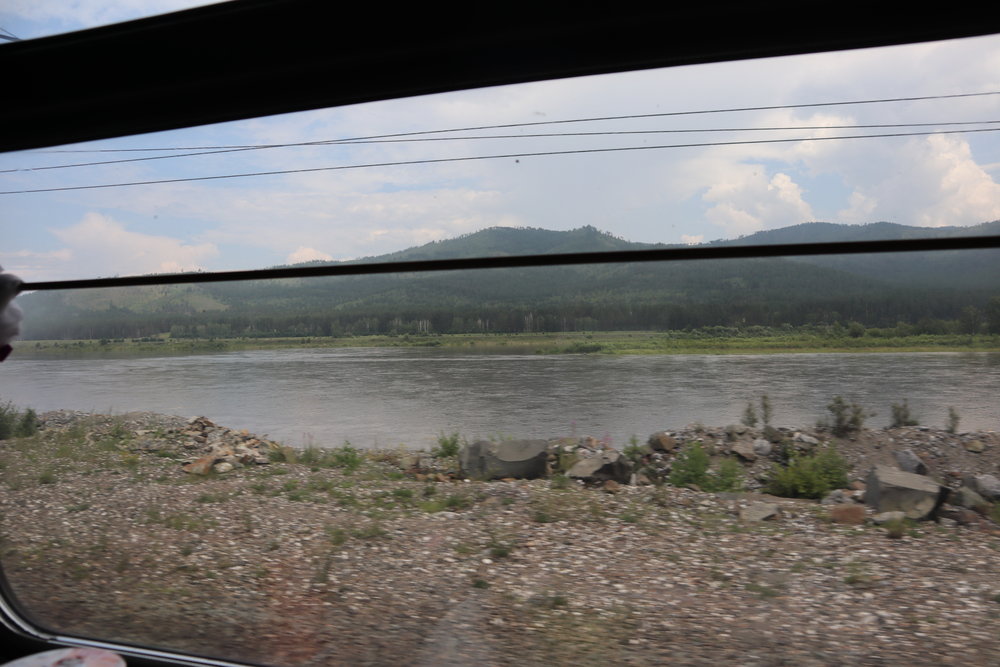
Trans-Mongolian Railway (RZD) Second Class – Scenery near Irkutsk
I headed to the provodnitsa’s quarters to borrow some of those distinctive Russian Railways mugs for tea. This would be our last chance to drink out of these ornate vessels, since our next leg from Ulaanbaatar to Beijing would no longer be with Russian Railways (RZD) but instead with Ulaanbaatar Railways (UBTZ), Mongolia’s national railway.
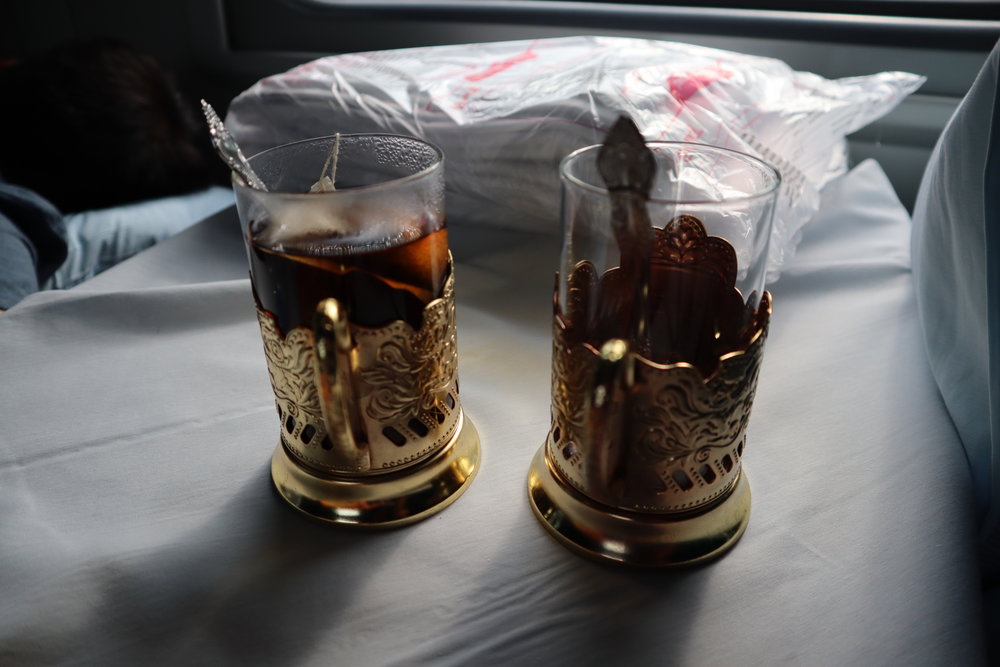
Trans-Mongolian Railway (RZD) Second Class – Tea
Speaking of which, if you’re making the train journey between Russia and China, you have the choice of riding the rails on Russian (RZD), Mongolian (UBTZ), or Chinese (CR) trains, or even a mix of all three. This time we’d be splitting up the trip across the first two providers, but next time – if there is one – I definitely want to try out the Chinese weekly service from Beijing to Moscow.
We chatted with our new Korean-Mongolian friend, although we never managed to figure out his exact life story. He did share some of his Korean snacks with us though, which was a nice gesture.
A few hours into the journey, the provodnitsa came by to hand out the Mongolia immigration forms.

Trans-Mongolian Railway (RZD) Second Class – Immigration forms for Mongolia
This was a slightly older train than the Rossiya, so there were no power plugs in the compartments themselves, but instead they were located plentifully in the train corridor itself, as well as in the bathroom.
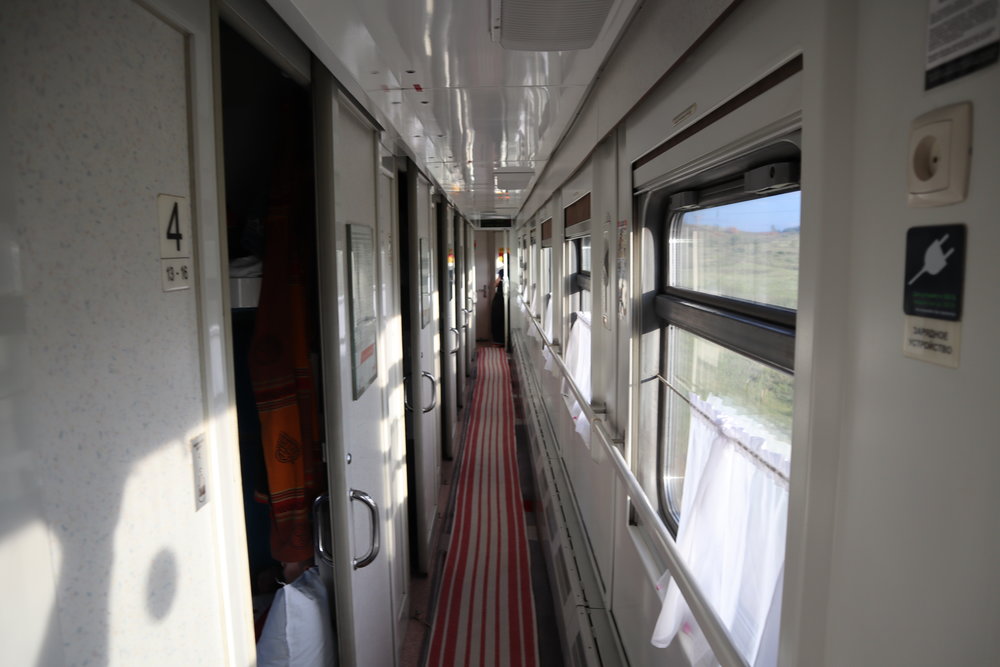
Trans-Mongolian Railway (RZD) Second Class – Train corridor
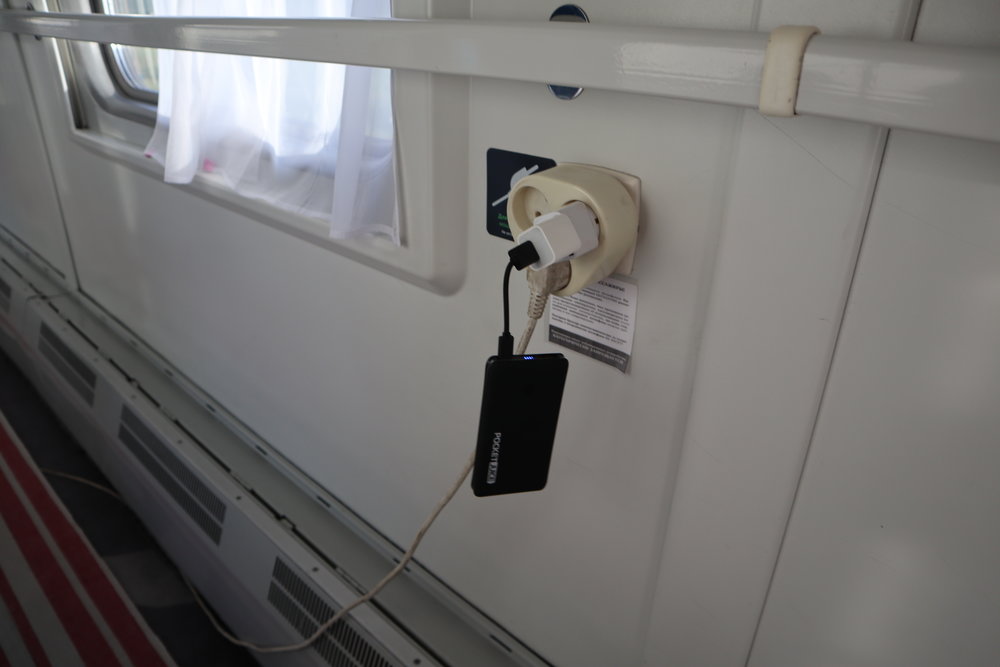
Trans-Mongolian Railway (RZD) Second Class – Power plugs
Before long, I had to make the customary first trip to the bathroom. There’s always an element of mystery about the bathrooms on each train journey, since you never really know what you’re going to get. The bathrooms on First Class and Third Class had been very much tolerable, with the exception of that disgusting stench in Third Class, so I was curious how this one would compare.
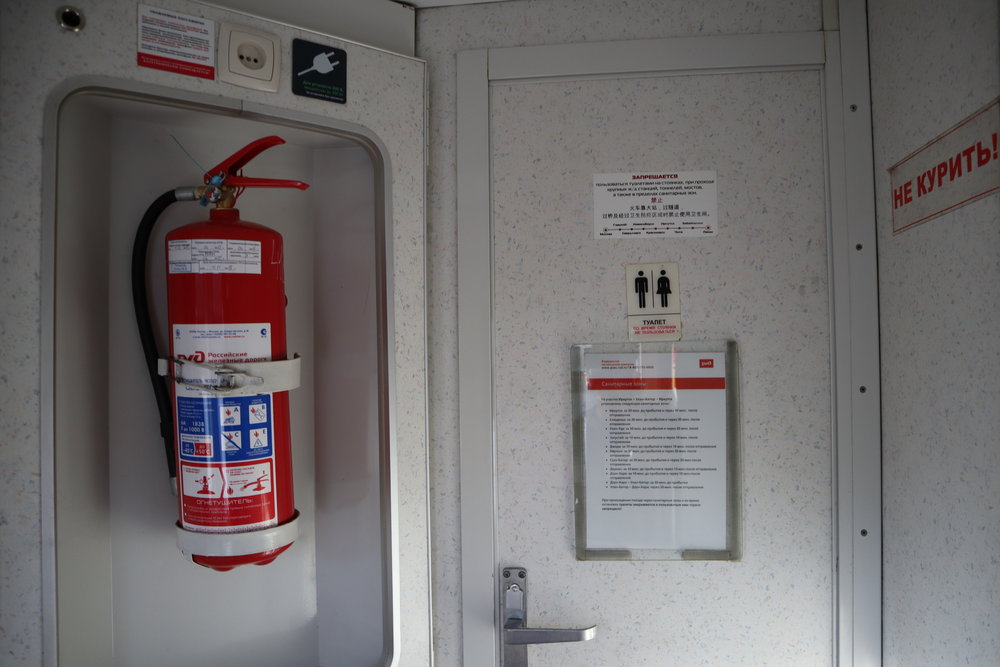
Trans-Mongolian Railway (RZD) Second Class – Bathroom
To my surprise, the bathroom on this train was configured very differently from the two previous ones. Instead of being arranged perpendicular to each other, the sink and bathroom are positioned diagonally in opposite corners.
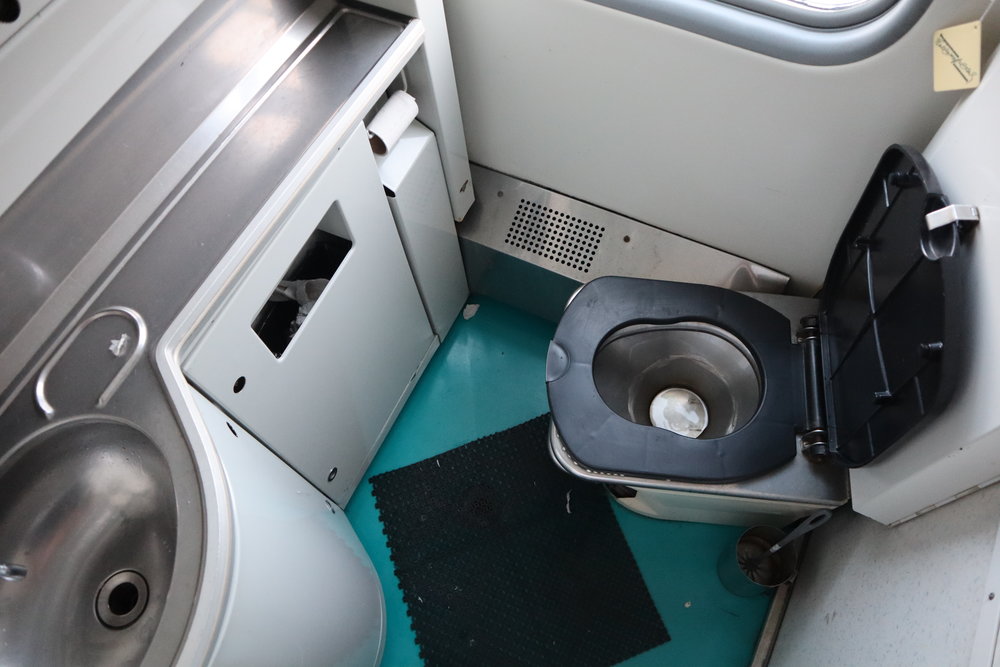
Trans-Mongolian Railway (RZD) Second Class – Bathroom
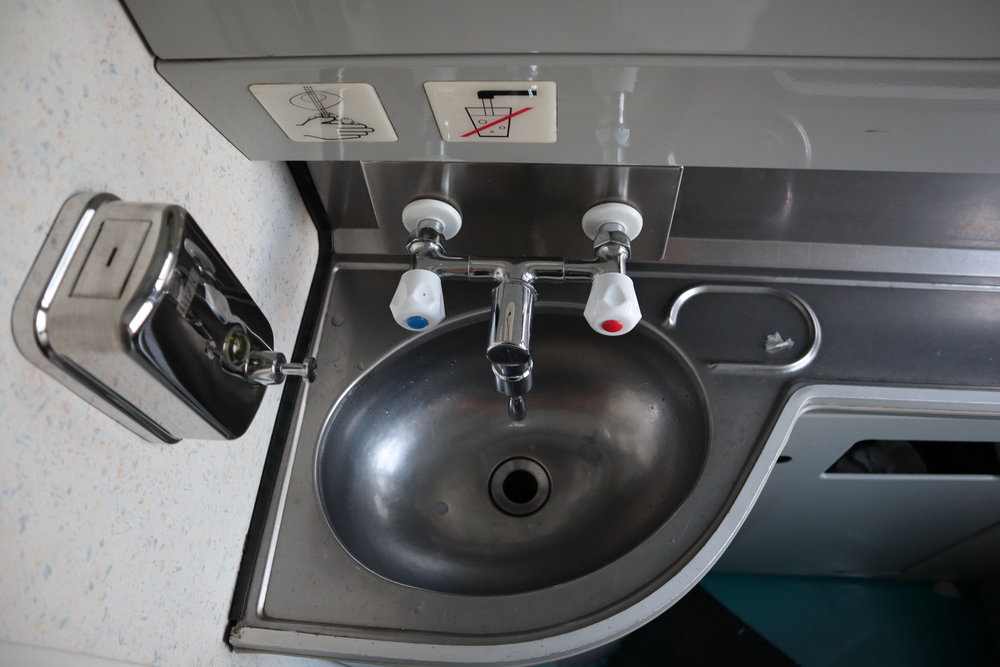
Trans-Mongolian Railway (RZD) Second Class – Sink
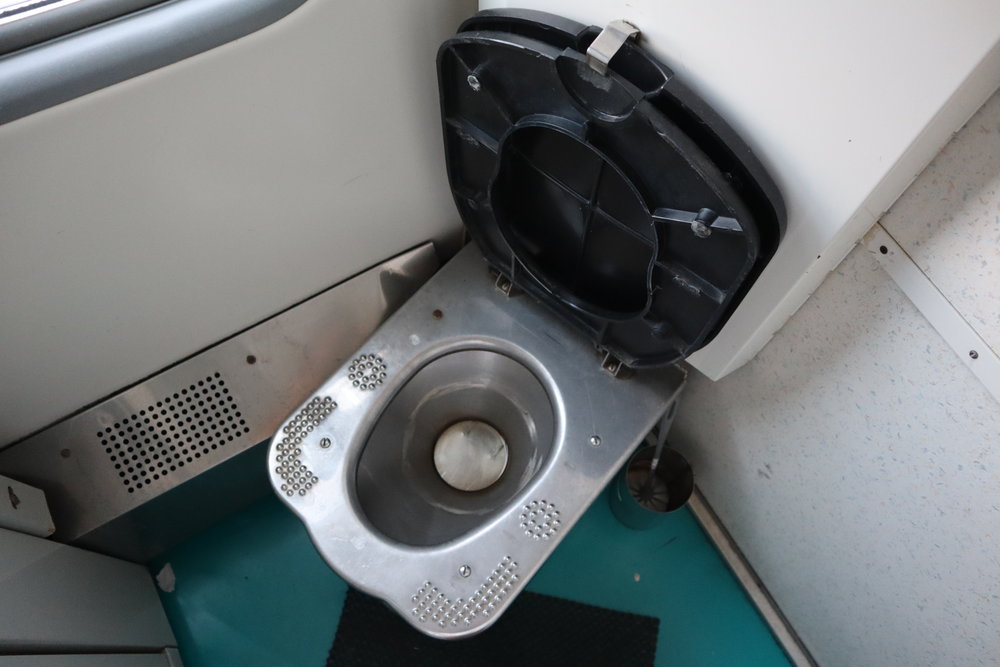
Trans-Mongolian Railway (RZD) Second Class – Toilet
The toilet flush was operated using a foot lever, which I appreciated for hygienic reasons. Overall the bathroom was again not too unpleasant and thankfully didn’t come with any noticeable odour at all.
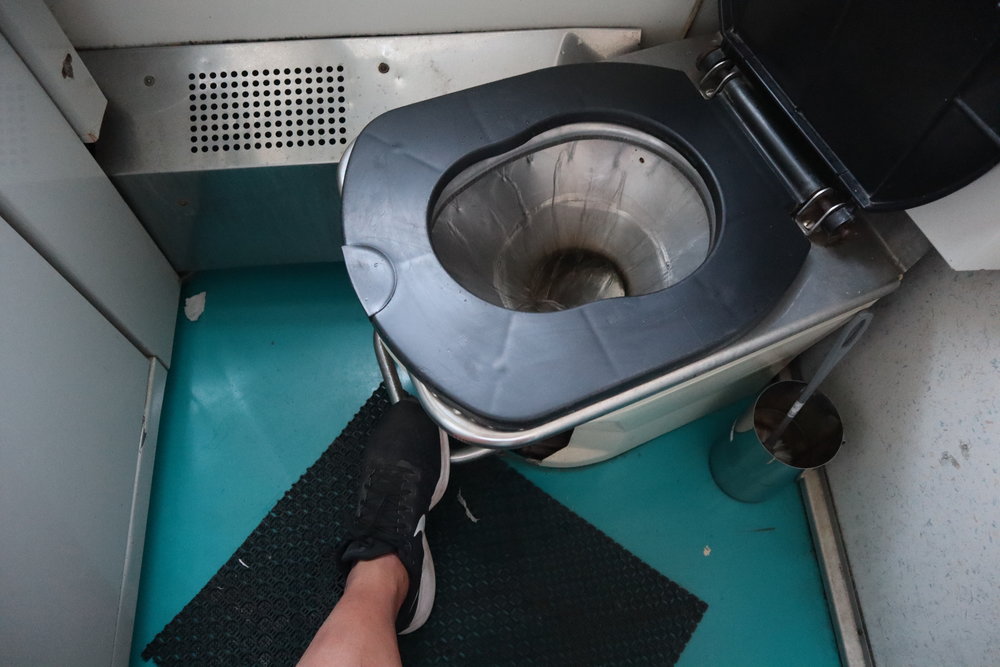
Trans-Mongolian Railway (RZD) Second Class – Toilet flush
Six hours into the journey, we had followed the southern edge of Lake Baikal into the Republic of Buryatia, whose capital of Ulan-Ude would play host to a 45-minute pit stop. In fact, Ulan-Ude would be the only stop at which we could get off the train for a meaningful amount of time, since the other major stops would be along the Russia–Mongolia border.
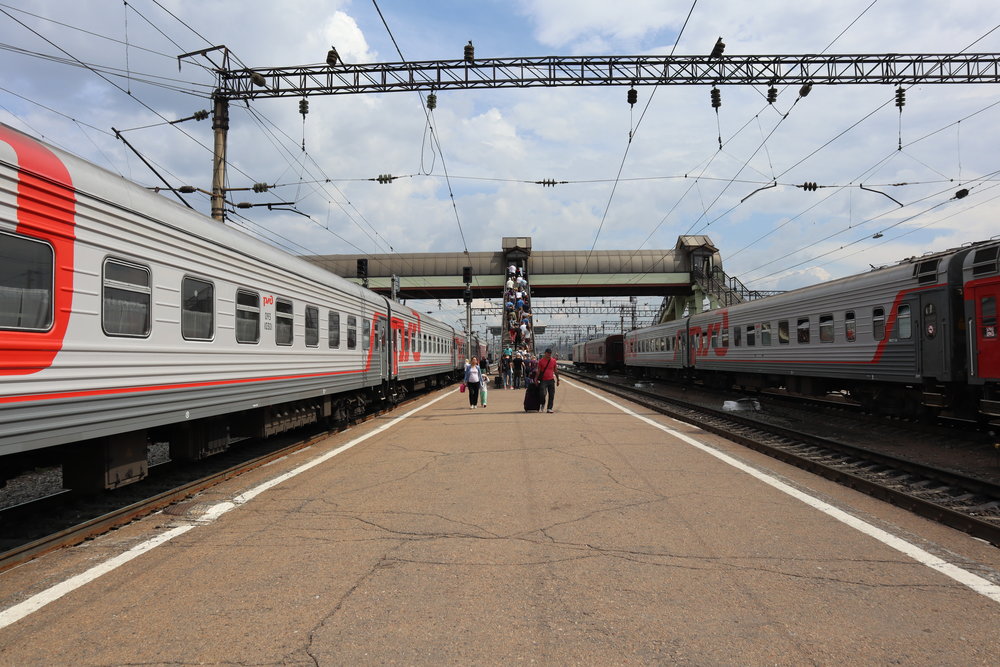
Ulan-Ude Railway Station
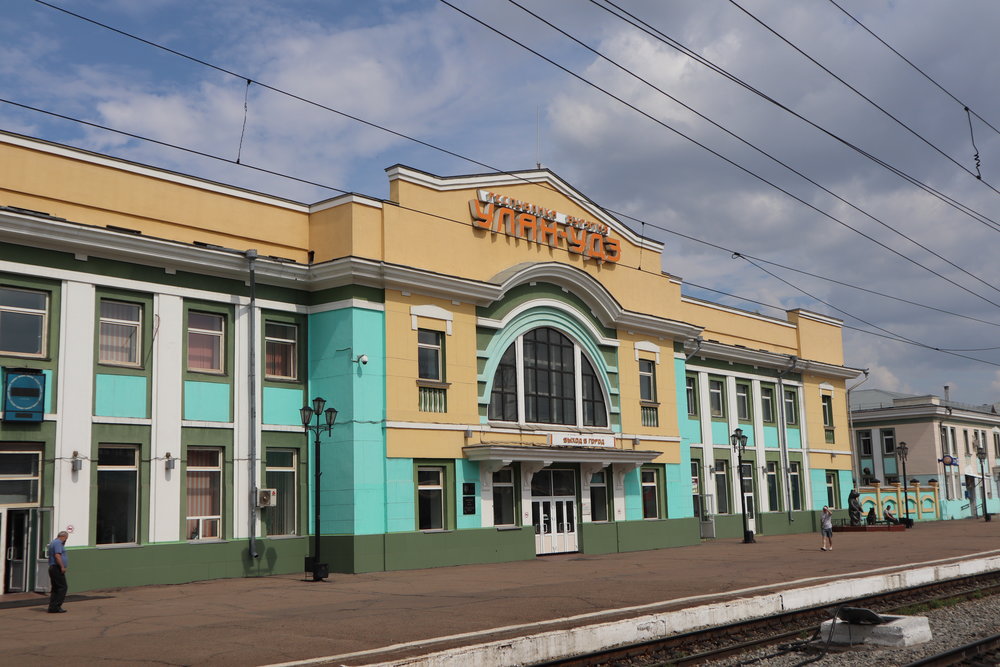
Ulan-Ude Railway Station
We got off the train to stretch our legs. I even ventured through the train station and checked out the street scene in Ulan-Ude on the other side. This place is another popular place for Trans-Siberian travellers to get off and stay for a few days, as its home to the gigantic Lenin Head Monument as well as the fascinating culture of the indigenous Buryat peoples.
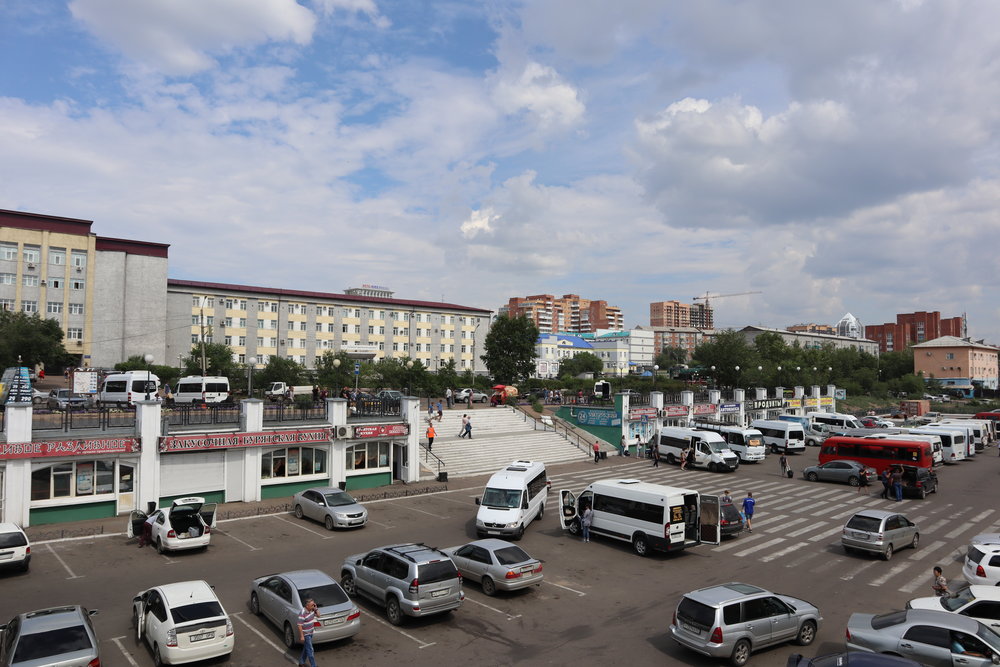
Ulan-Ude street scene
Our train had to change locomotives at Ulan-Ude, presumably due to the upcoming international border crossing. A crowd of people gathered on the platform to watch the old locomotive detach from the train and sputter away before the new one backed into its place.
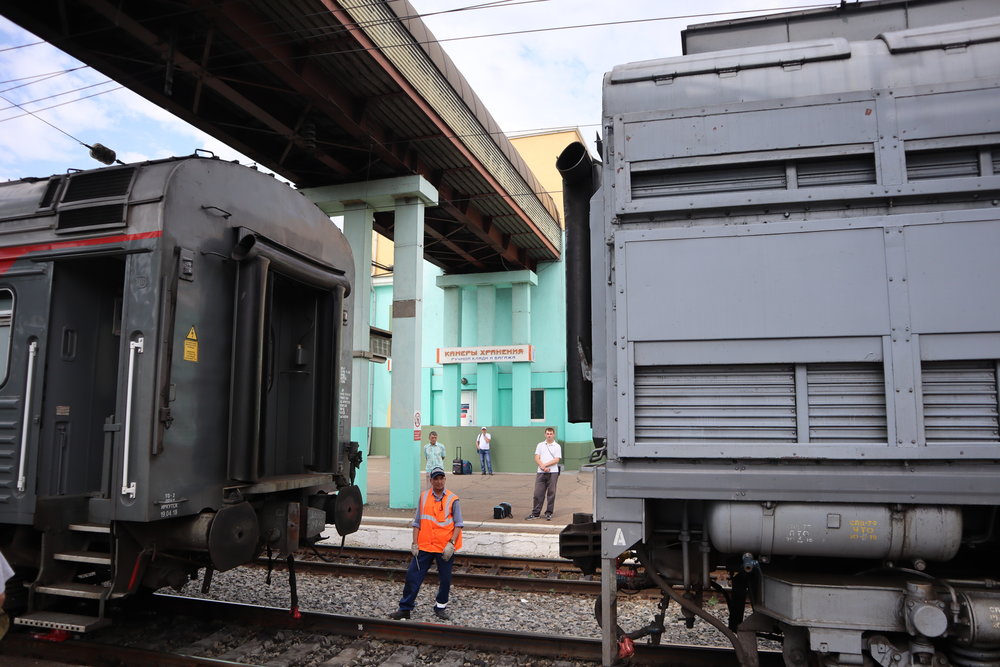
Locomotive change in Ulan-Ude
Once we were back on the train, it’d be a further eight hours until the border. As you can see from the onboard schedule, Trains 305/306 run a dedicated service between Irkutsk and Ulaanbaatar and they really don’t make many stops.
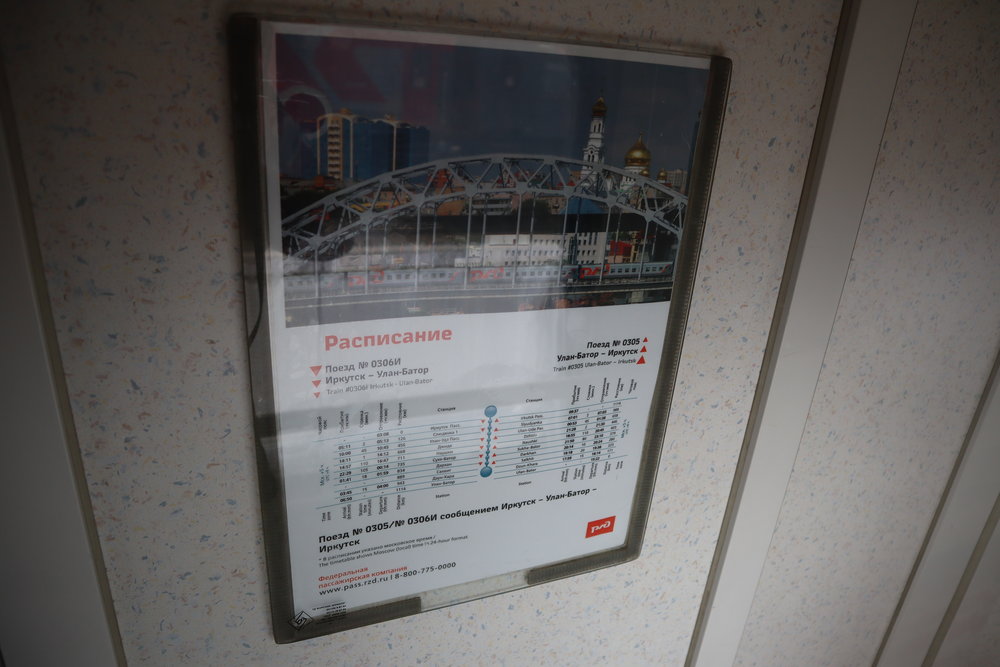
Trans-Mongolian Railway (RZD) Second Class – Train schedule
Having spent many days’ worth of time on the train by now, Jessica and I had settled into a rhythm of Netflix, reading, snacking, and napping. As far as I could tell, there was no restaurant car on this train, so we churned through a few more flavours of Russian instant noodles (which I have to say are quite inferior to the Chinese brands I’m used to).
The occasional glance out the window along this part of the rails also proved rewarding, since the landscape was beginning to transform from the Siberian taiga into the vast Mongolian plains.
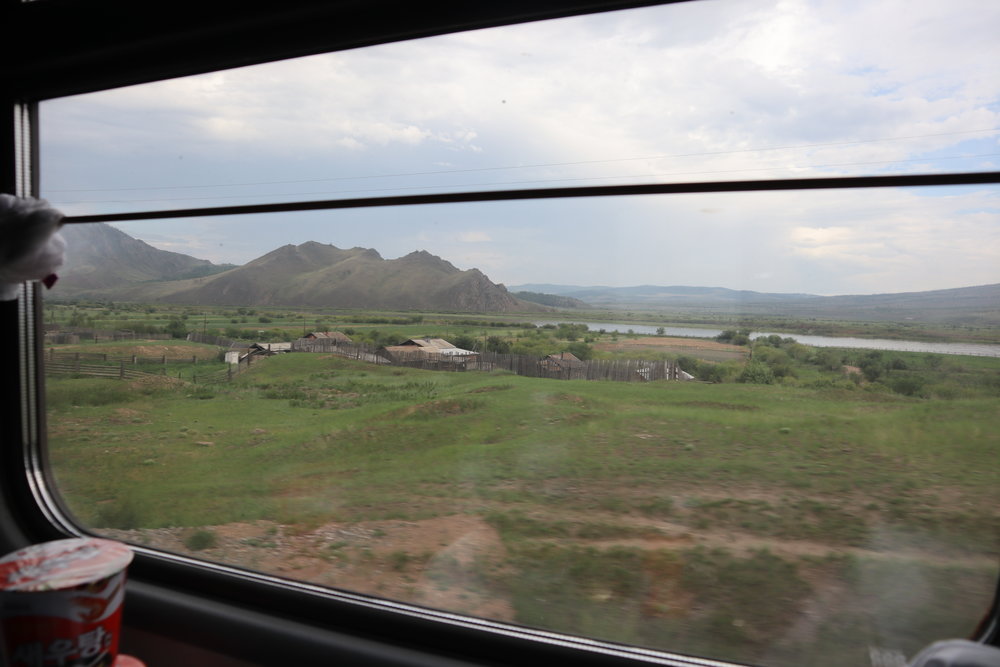
Trans-Mongolian Railway (RZD) Second Class – Scenery near Ulan-Ude
We also had the in-suite TV on in the background, but as before it would only cycle through a handful of grainy Russian soap operas, so it was more ambient noise than anything.
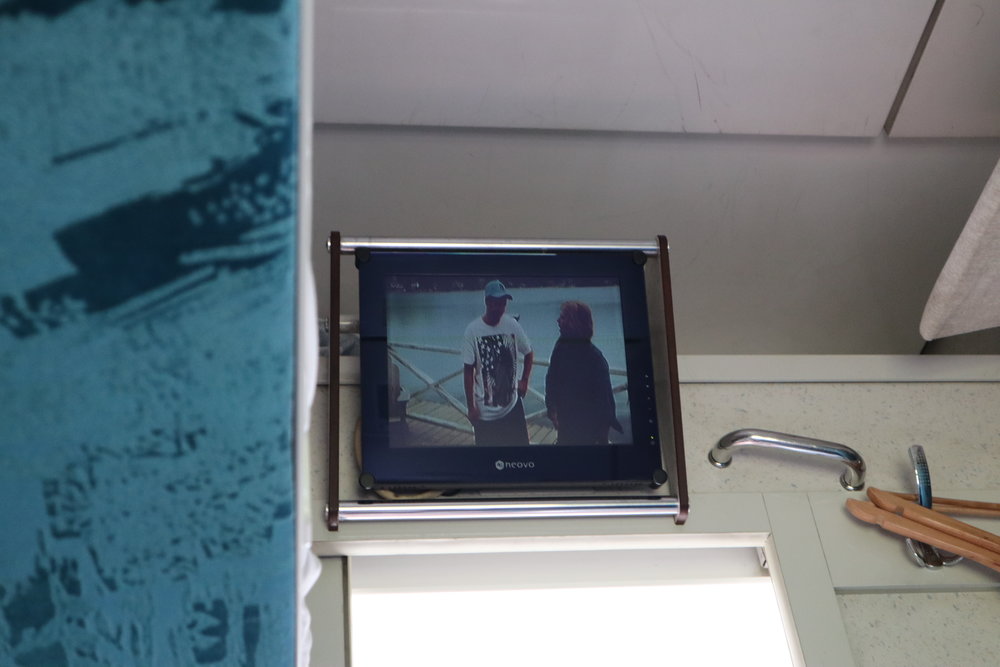
Trans-Mongolian Railway (RZD) Second Class – Television
Upon pulling into the train station at Naushki, the Russian border town, the provodnitsa came by everyone’s compartments to let them know that we could get off the train to stretch our legs for “10 minutes only”. We stepped off onto the platform for some much-needed jumping jacks, before being hustled back on the train for the immigration process.
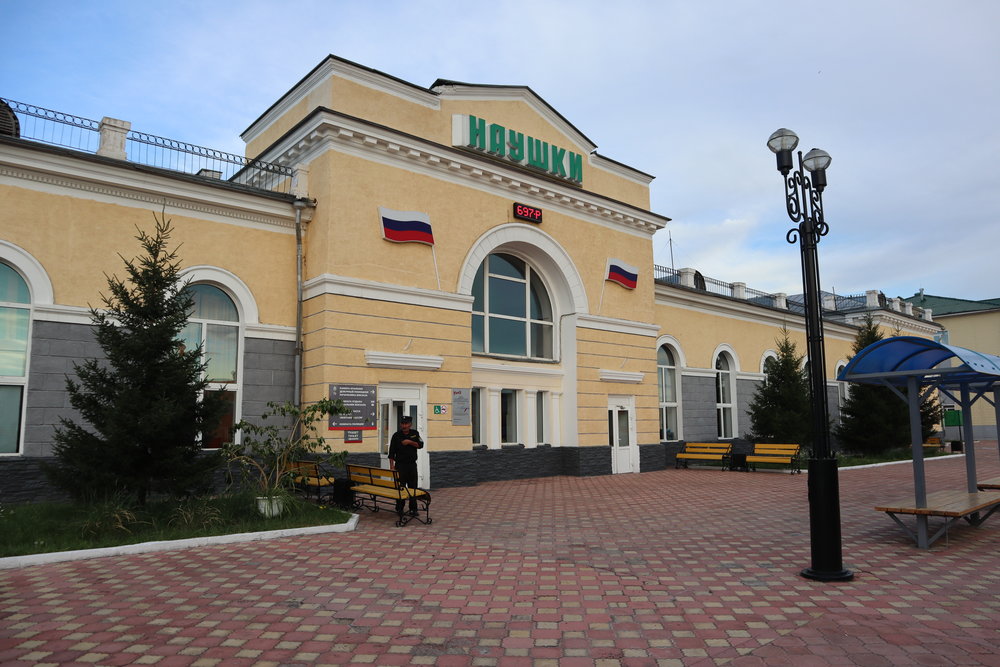
Naushki Railway Station
Basically, Russian immigration officers would board the train to check everyone’s documents and issue the exit stamp. They also performed the role of customs officers, so they’d request to open up some of your luggage to make sure you weren’t smuggling out vast amounts of drug-laden matryoshka dolls, fresh Lake Baikal water, or what-have-you. The train would then make the short journey across the border, where Mongolian officers would repeat the task.
The Russian officer who arrived at our compartment demanded that we open our luggage and ruffled through its contents. His demeanour was a little aggressive, but not out of character for an immigration officer on a late-night shift.
He flipped through our passports looking for a Russian visa, but was unable to find one. Curiously, when we handed him our Fan IDs – which we used to visit Russia during the FIFA World Cup – he disappeared with all our documents for a good twenty minutes or so. Presumably he went to verify the Fan IDs with his superiors, given that they probably don’t see many World Cup spectators exiting the country here at the Mongolian border.
Upon returning, he handed us back our passports, in which our exit from Russia via the border town of Naushki (На́ушки) had been rubber-stamped. There was even a little train symbol to represent the method of transport, which was very satisfying indeed.
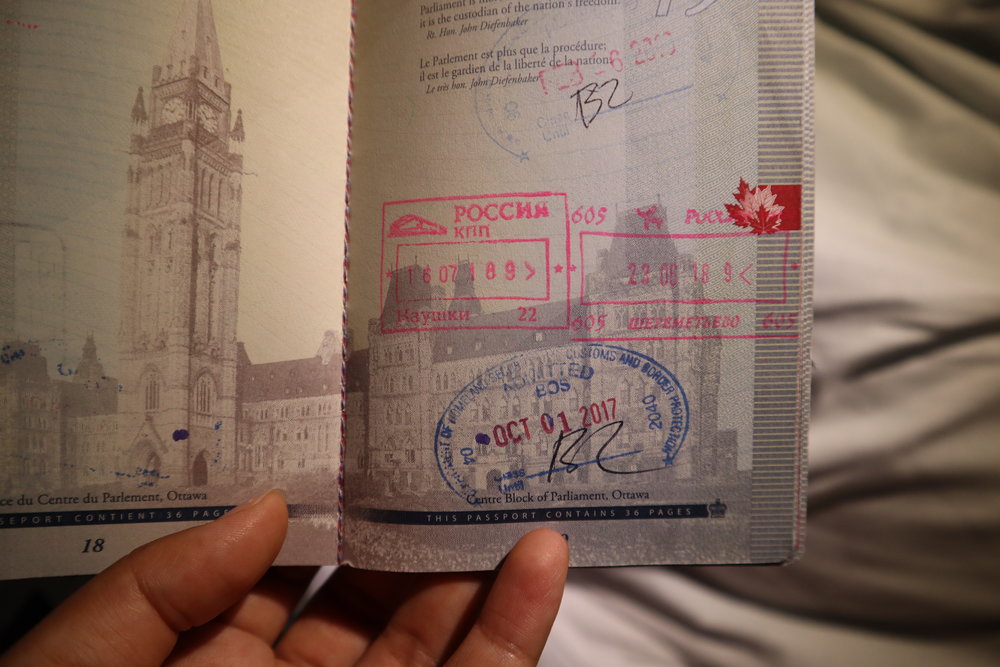
Trans-Mongolian Railway (RZD) Second Class – Russian exit stamp
A quick dash across the border brought us to the Mongolian town of Sukhbaatar. This time, our documents had to be processed first before we’d be allowed off the train for “five minutes only”.
It was getting really late into the night by now, so I was grateful that the Mongolian border officers were far more efficient, stamping us into the country with little delay. Again, we got that little train symbol on our entry stamp, which will serve as a reminder of this amazing trip as I flip through my passport many years down the road.
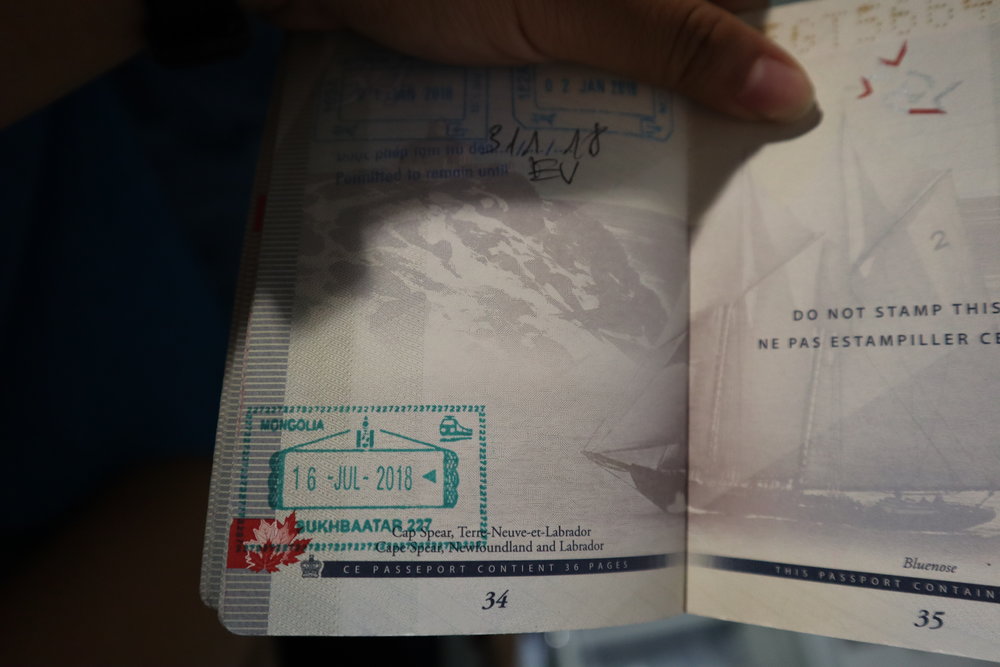
Trans-Mongolian Railway (RZD) Second Class – Mongolian entry stamp
When the border formalities were complete, I jumped off the train to get my first breath of fresh Mongolian air. I briefly wandered through the tiny train station at Sukhbaatar, beginning to absorb yet another unfamiliar foreign script.
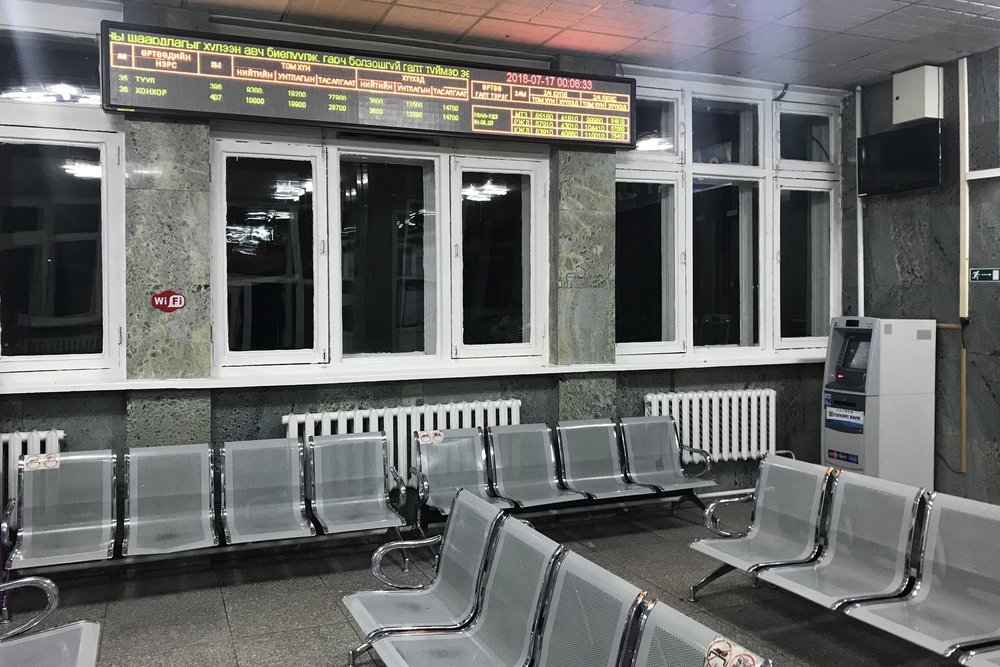
Sukhbaatar Railway Station
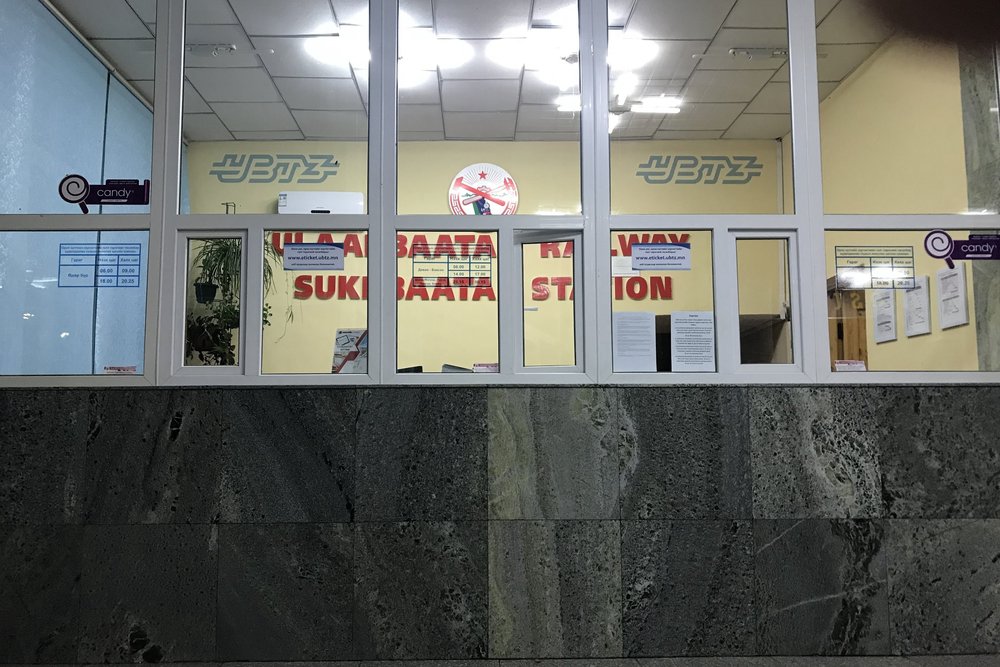
Sukhbaatar Railway Station
Back on the train, and once we were speeding through the countryside under cover of darkness, it was time to sleep for the night. This leg of the journey was perhaps the most “normal” in terms of our sleeping patterns – at only 22 hours in duration and with no time zone changes involved, it was certainly quite manageable to rely on our body clocks throughout the train ride.
We woke up to some spectacular views of the Mongolian plains not far outside of Ulaanbaatar.
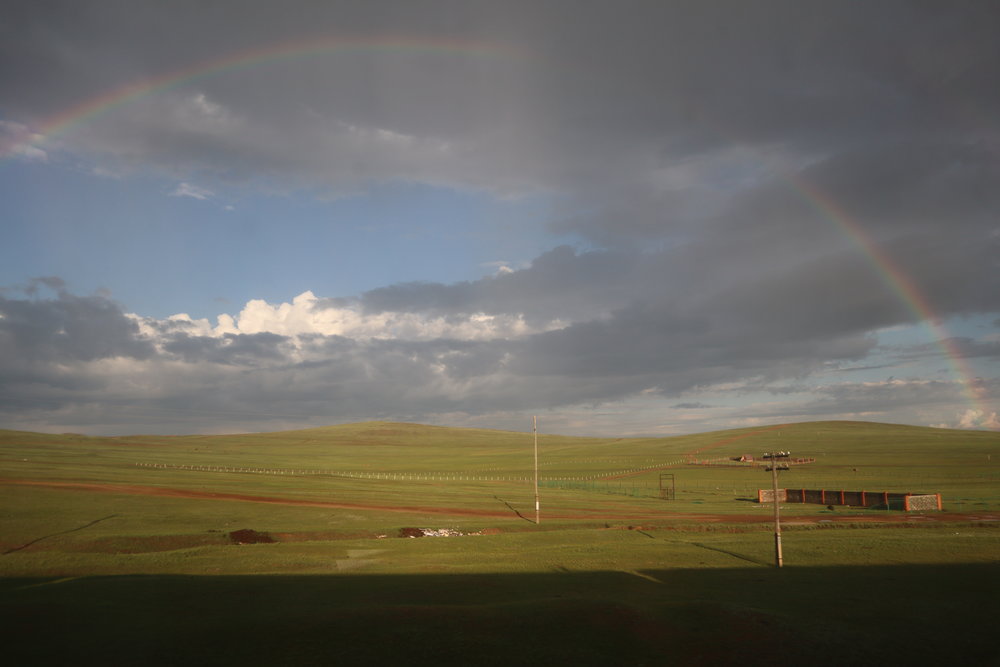
Trans-Mongolian Railway (RZD) Second Class – Scenery near Ulaanbaatar
Our arrival in Mongolia’s capital was scheduled for 6:50am, and we pulled into the station just a few minutes after. We waved goodbye to our travel companion, stepped onto the platforms of Ulaanbaatar Railway Station, and ventured for our hotel – the strategically-chosen Best Western Gobi’s Kelso located only a five-minute walk away.
Conclusion
To me, Second Class was the perfect “middle ground” option for travelling along the Trans-Siberian Railway. It gives you the privacy of the individual compartments with sliding doors that you’d find in First Class at a reasonably cost-efficient price point that’s not much higher than Third Class. The journey between Irkutsk and Ulaanbaatar was particularly easy-going, clocking in at a relatively manageable 22 hours and affording some killer views that provide a taste of what’s to come once you arrive in Mongolia.


